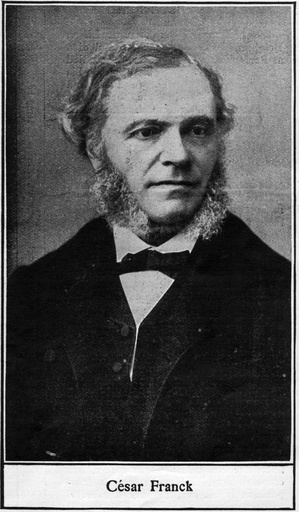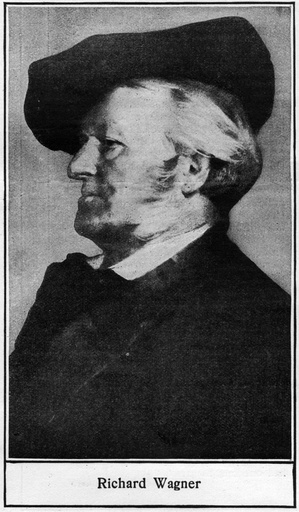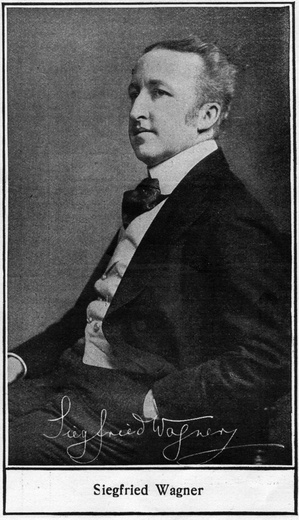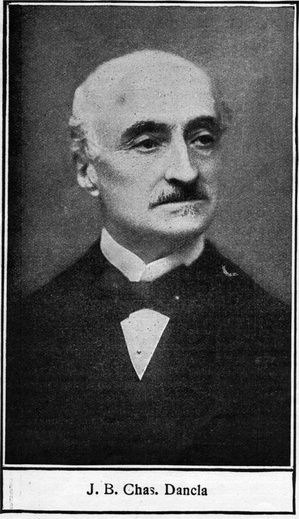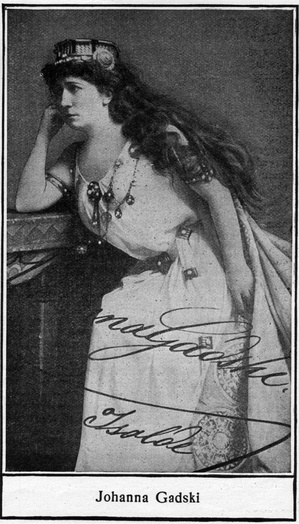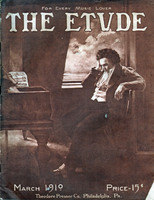(Frahnk.)
César Franck was born at Liège, Belgium, December 10, 1822, and died at Paris, November 8, 1890. He studied first in the town of his birth, but in his fifteenth year he went to Paris and entered the Conservatoire, then under the direction of Cherubini. In 1838 he gained an accessit in counterpoint and fugue, and subsequently the first prize for piano playing. He then entered the composition class of Berton, and in 1840 won the first prize for counterpoint and fugue. In October, 1840, Franck entered the organ class of Benoist and in 1841 obtained the second prize. He then returned to Belgium, but two years later found him again in Paris, where he established himself with his family in 1844. From that time he worked hard, frequently giving ten one- hour lessons a day in piano, accompaniment and harmony, besides composing steadily. In 1858 he became organist at St. Clothilde, a position he fulfilled until he died. In 1872 he became professor of the organ at the Conservatoire, but, in spite of his arduous duties, continued to compose great works. Franck is a singular instance of a man, confident in his own ability, a master of every musical resource, who was alike indifferent to the criticisms and praises of all outside his own immediate circle. People are still arguing as to whether his music is good or bad, but there can be no doubt that it has come to stay. His most famous composition is his oratorio Les Béatitudes.
(Vahg'-ner.)
Wagner was born at Leipsic, May 22, 1813, and died at Venice, February 13, 1883. His first important work was Rienzi, which was followed by The Flying Dutchman, Tannhäuser and Lohengrin. While Wagner's domineering disposition and revolutionary ideas made him many enemies, his wonderful genius earned him the powerful friendship of Liszt, Schumann and others. Wagner made his living by his pen as well as his music, and owing to his political opinions was obliged to leave Germany in 1849, and, with the assistance of Liszt, he fled to Paris and later to Zurich. He also visited London. In 1861 he was permitted to return to Germany, and the same year he separated from his first wife, Wilhelmine, whom he had married in 1836. Tristan, after fifty-seven rehearsals at Vienna, was given up as impossible. More failures followed, but in 1864 Ludwig II of Bavaria invited him to Munich, and, aided by royal support, together with that of the numerous "Wagner Societies" which now began to spread throughout Germany, Wagner was enabled to build his "ideal theatre" at Bayreuth. Here were produced the marvelous music dramas which have completely revolutionized the whole of modern music. Wagner married Cosima, the daughter of Franz Liszt, by whom he had one son, Siegfried.
Siegfried Wagner, the son of Richard and Cosima Wagner, and grandson of Liszt, was born at Triebschen, June 6, 1869. It was originally intended that he should be an architect, and until his twenty-first year his education was directed to that end, but no man with such ancestors as Siegfried Wagner possesses could be expected to be satisfied with the coldly intellectual pleasures of architecture, and it was inevitable that he should become a musician. His education in music was placed in the able hands of Kniese and Humperdinck, and he made his début as a conductor August 5, 1893. He is an exceedingly able musician, and has composed a symphonic poem entitled Sehnsecht, and the operas, Der Barenhauter, 1899; Herzog Wildfang, 1901, and Der Kobold, 1904, etc. His works have been performed with success in Germany, England, and in this country. Siegfried Wagner has conducted the Bayreuth festivals with success. It is a little difficult for a man to be the son of a genius, and it cannot be said that Siegfried Wagner bears the mantle of his illustrious father, but nevertheless, he is a musician whose abilities have won him the respect of all those whose musical opinion is of value, and there is yet time for his musical powers to develop more fully.
(Dahnk'-lah.)
Dancla was born at Bagnères de Bigorres, December 19, 1818, and studied the violin under Baillot at the Paris Conservatoire, where he ultimately became a professor of violin playing in 1857. He was successful as a soloist, and his Quartet Soirées, in which he appeared, together with his brothers, Leopold, the violinist, and Arnaud, the violoncellist, were very popular in Paris. He was very successful as a composer, and gained many prizes. While his more ambitious pieces are not of a character which will make them long remembered, Dancla has written a number of short pieces for the violin which are exceedingly popular with violinists. He had great skill in writing for his instrument pieces especially adapted for various grades of students. Grove declares that "his Etudes are of considerable value to teachers, especially those bearing the title Accentuation et Ponctuation de l'archet." Probably the most popular of his works are the six Airs Variées, and the twelve opera fantasias, all of which are extremely skilfully written for the violin. He died in 1907, and is usually regarded as the last living representative of the old French school of violin playing. He published about 130 works in all.
Mme. Gadski was born at Stettin, June 15, 1871, and commenced to study singing in her tenth year with Mme. Schroeder-Chalupka, one of the most famous singers and teachers of the day. Mme. Gadski made her operatic debut at Kroll's Theatre, Berlin, where she appeared as Undine in Lortzing's opera of that name. Her success was so great that she was immediately engaged for the next season, and remained at the theatre until 1893. In the following year she toured through the principal cities of Germany and Holland, and made her first appearance at the Royal Opera House, in Berlin. It was there that Walter Damrosch heard her and made her an offer to come to the United States. She made her début at the Metropolitan Opera House, New York, March 1, 1895, as Elsa in Lohengrin, and was for two more seasons with the Damrosch-Ellis Company. In 1898 Mme. Gadski became a member of the Grau Opera Company, at New York, and upon the retirement of Maurice Grau, in 1903, she went to the Metropolitan Opera House. She has appeared at Covent Garden, London, with great success, and in 1899 sang the part of Eva in Die Meistersinger at Bayreuth. Since 1904 she has been chiefly engaged in concert work and has had notable success along this line. She has come to be regarded as one of the foremost singers of Wagner opera, and has thoroughly earned her high reputation.
(Strouss.)
Strauss was born at Vienna, March 14, 1804, and died there September 25, 1849. His parents would not allow him to study music, so he ran away from home. However, a friend took him back and persuaded them to allow him to study the violin. He showed great aptitude and received many engagements to play at private houses. At fifteen he entered Pamer's orchestra at the "Sperl," a favorite place of amusement in the Leopoldstadt, Vienna. He soon afterwards became associated with Lanner's orchestra. In the Carnival of 1826 Strauss and his orchestra played at the "Swan," in the Rossau suburb, and achieved great success. It was at this time that he wrote the first of the waltzes with which his name is indissolubly associated. Bigger engagements followed at the "Sperl" again, and Strauss became Capellmeister of the First Bürger Regiment, and was entrusted with the music art the court fêtes and balls. He then went on tour throughout Europe with unprecedented success. Paris went wild over him. London and the English provinces scarcely allowed him time to sleep, and in Holland, Germany, and, in fact, wherever he went the same kind of thing occurred. In subsequent tours similar successes awaited him. He married in 1824 and had five children. Of his many beautiful waltzes, The Beautiful Blue Danube is perhaps most famous.


